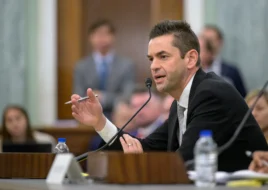Let’s take a look back at the year in space policy, which included the finish lines for some initiatives—and the reopening of previously closed cases for others.
Space policy by the numbers:
- $25.4B: The fiscal 2025 NASA budget request, released in March
- $29.4B: The fiscal 2025 Space Force budget request
- 2: The number of space bills marked up by the House Science, Space, and Technology Committee
- 0: The number of National Space Council meetings
- 15: The number of nations who signed the Artemis Accords this year
Crossing guard: A piece of space policy from 2018 finally came to fruition in 2024 when the Office of Space Commerce launched the first iteration of its Traffic Coordination System for Space (TraCSS), making good on Space Policy Directive-3’s order to shift the nation’s space traffic management system from DoD to the Commerce Department.
Under TraCSS Phase 1.0, which launched on Sept. 30, the office started to provide space situational awareness data to a beta group of satellite operators. There’s still a lot more to do—and the government will be working closely with the commercial sector to build out the service—but it’s a significant first step for a long-awaited transfer of responsibilities.
Circle back: If the space industry had a recap akin to Spotify Wrapped, debate about Part 450 would take the top spot for space policy wonks. Just three years after the FAA’s new Part 450 launch and reentry licensing regulations took effect, FAA space chief Kelvin Coleman announced in February that the agency would launch a committee to reconsider the rules after blowback from industry.
The rulemaking committee was officially established last month, but the delay didn’t stop stakeholders from industry and Congress from voicing their concerns.
Next chapter: With the ISS’ end of life looming at the end of the decade, conversations ramped up in 2024 over what comes next. A number of industry players, including Axiom, Vast, and Voyager, are waiting in the wings to pick up the mantle on human spaceflight in LEO when NASA takes a step back, but there’s still debate about what that will look like—and what it means to maintain a continuous presence in orbit.
What’s next: The year’s not over yet, and Congress still has roughly a dozen days in session. During that time, lawmakers are expected to approve the fiscal 2025 National Defense Authorization Act, which includes a range of national security space priorities.
Some committee leaders have also been eager to pass a new NASA authorization act…but that will likely have to wait until 2025.




